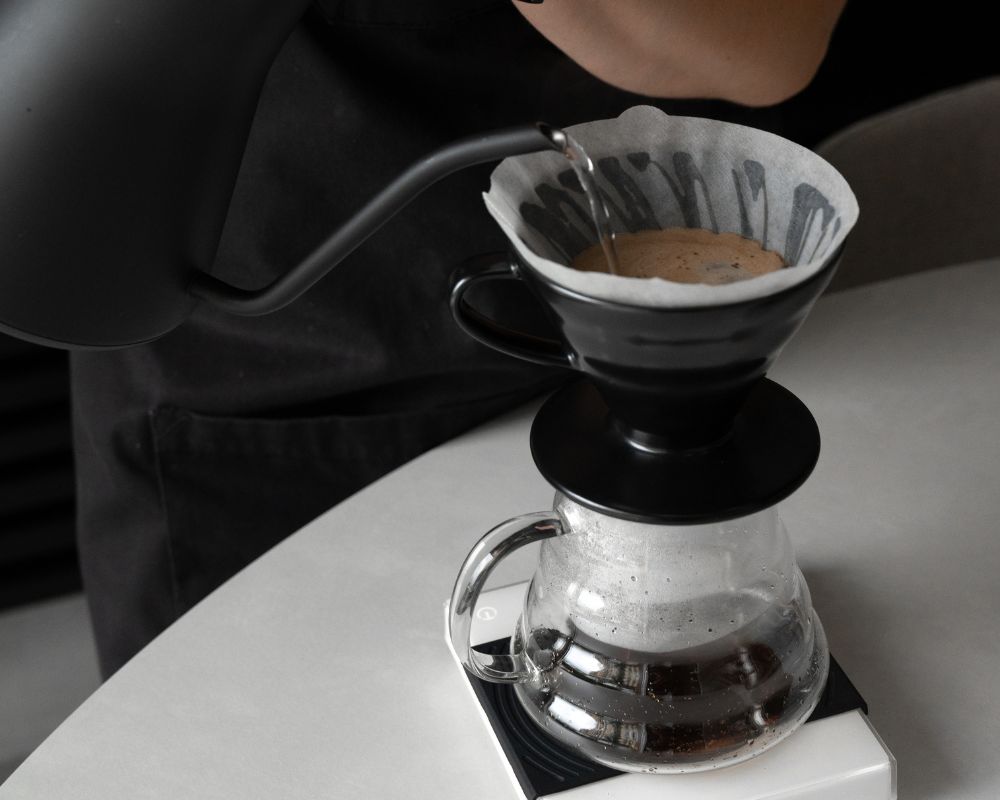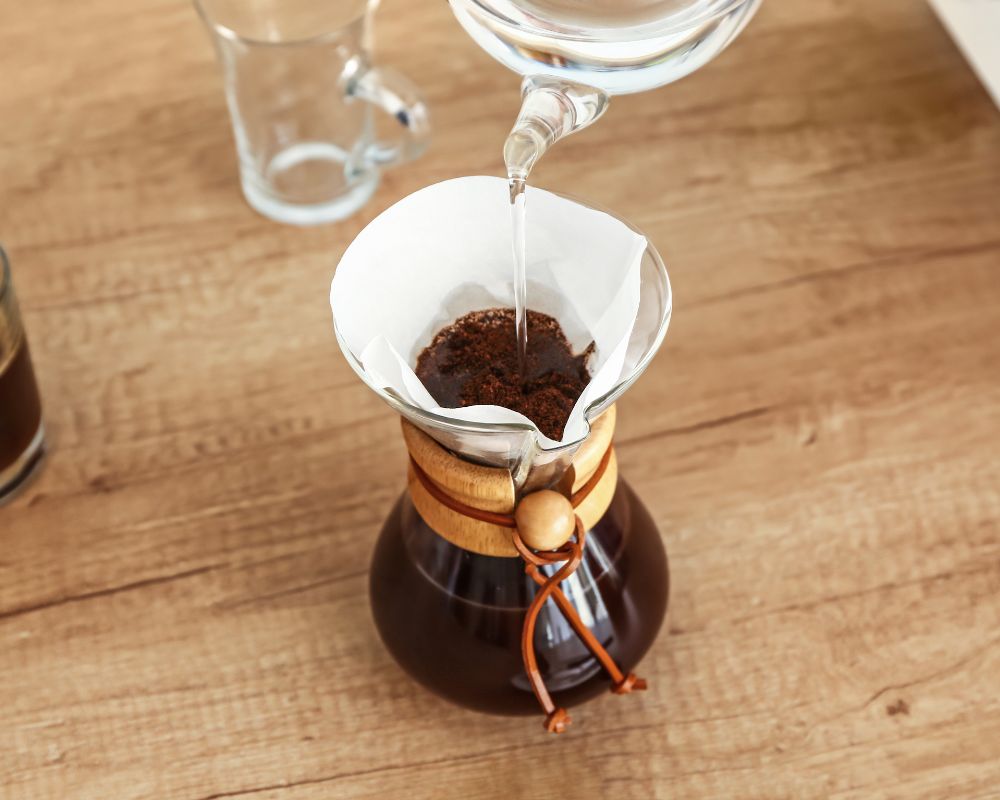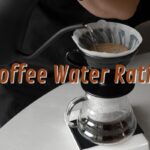Coffee water ratio. If you’re a coffee lover, achieving the perfect cup requires more than selecting high-quality beans and an excellent brewing method. One of the most crucial elements in coffee making is the coffee-water ratio. This Ratio refers to measuring coffee grounds to water used in the brewing process.
Getting the coffee-water ratio right is essential for bringing out the best flavor and aroma in your coffee. Too little water can result in a weak and tasteless brew, while too much water can over-extract the coffee, leading to a bitter and unpleasant taste.
A balanced scale with coffee beans on one side and water droplets on the other. The importance of the coffee-water ratio and how mastering it can help you brew like a pro. You’ll learn the ideal coffee-water ratio, how to calculate it for different brewing methods, and how to adjust it based on personal preference.
We’ll also explore the impact of water quality on the coffee-water ratio and discuss how to troubleshoot common issues that may arise. By the end of this article, you’ll have all the knowledge you need to take your coffee brewing skills to the next level.
Understanding the Coffee Water Ratio

Before calculating the ideal coffee-water ratio, let’s first understand what it is and why it’s essential. Simply put, the coffee water ratio is the amount of coffee grounds to the amount of water used in the brewing process.
The ideal coffee-water ratio is crucial in achieving a delicious cup of coffee. Using too much water may make your coffee weak and lack flavor. On the other hand, if you use too little water, your coffee will be too strong and could taste bitter or over-extracted.
So, finding the perfect balance is critical. The ideal coffee-water ratio typically ranges from 1:15 to 1:18, with 1:16 being the most commonly used Ratio.
Using the right coffee-water ratio ensures you extract just the right flavor from your coffee grounds, resulting in a rich, full-bodied cup of coffee.
Ideal Coffee Water Ratio
As previously mentioned, the ideal coffee water ratio typically ranges from 1:15 to 1:18. For every gram of coffee, you’ll need 15-18 grams of water.
However, remember that the ideal Ratio can vary depending on personal preference, the type of coffee bean, and the brewing method used.
For example, some people prefer a stronger cup of coffee and may use a 1:14 ratio. The French press brewing method, on the other hand, requires a coarser grind and a higher ratio of 1:16 to 1:18.
Ultimately, finding the ideal coffee-water ratio involves experimentation and adjustment based on individual preferences.
"Using the right coffee water ratio ensures that you extract just the right amount of flavor from your coffee grounds, resulting in a rich, full-bodied cup of coffee."
Calculating the Coffee Water Ratio
Calculating the coffee-water ratio can be an exact science, but it doesn’t have to be complicated. You can achieve the perfect coffee-water ratio for your preferred brewing method with a few simple calculations.
The basic formula for calculating the coffee-water ratio is as follows:
Coffee Water Ratio = Amount of Coffee ÷ Amount of Water
To help you get started, refer to the table below for some recommended coffee-water ratios based on different brewing methods:
| Brewing Method | Coffee Water Ratio |
| Drip Coffee | 1:15 |
| French Press | 1:12 |
| Pour Over | 1:16 |
Remember that these ratios are just guidelines, and you may need to adjust them based on your taste preferences.
If you’re using a scale to measure your coffee and water, it’s easy to calculate the coffee-water ratio. Weigh the coffee and water separately, then divide the coffee’s weight by the water’s weight. For example:
- Weigh out 20 grams of coffee.
- Weigh out 300 grams of water.
- Divide 20 by 300 to get a coffee-water ratio of 1:15.
If you don’t have a scale, you can still calculate the coffee-water ratio using a measuring cup. One cup of water equals eight fluid ounces or approximately 225 grams. Use this information to measure your coffee and water, then calculate the Ratio using the above formula.
Now that you know how to calculate the coffee-water ratio, you can experiment with different ratios to find your perfect cup of coffee. Just remember to keep track of the measurements and ratios you use so you can replicate your results in the future.
Tips for Achieving the Perfect Coffee Water Ratio

Now that you understand the importance of the coffee-water ratio let’s explore some tips and tricks to help you achieve the perfect balance.
Use a Scale
When measuring your coffee and water, it’s important to be precise. Using a kitchen scale to measure the coffee and water by weight will provide the most accurate results and help you achieve consistency in your brewing process.
Experiment with Ratios
While there is an ideal coffee-water ratio for each brewing method, it’s also important to remember that personal preferences vary. Feel free to experiment with different ratios to find the taste profile that suits you best.
Adjust Ratios Based on the Coffee Age
The age of your coffee can affect the coffee-water ratio. As coffee ages, it loses its flavor and acidity, so you may need to adjust the Ratio slightly to compensate.
Consider Water Temperature
The temperature of your water can impact the extraction process and ultimately affect the coffee-water ratio. For example, if your water is too hot, it can lead to over-extraction and a bitter taste. Aim for a water temperature between 195°F and 205°F for optimal results.
Use High-Quality Water
The quality of your water can also affect the coffee-water ratio and the overall taste of your coffee. It would help to use filtered or spring water to avoid unwanted flavors or minerals.
Practice Consistency
Finally, practicing consistency is the key to achieving the perfect coffee-water ratio. Once you find the Ratio that works for you, stick with it and take note of any adjustments you make to your brewing process.
Importance of Water Quality
Now that you understand the coffee-water ratio, it’s time to talk about the impact of water quality on your coffee. The quality of water you use in your coffee directly affects its taste and flavor.
Water high in minerals, such as magnesium and calcium, can make your coffee taste bitter and unpleasant. On the other hand, using distilled or soft water can result in a flat and insipid cup of coffee.
The ideal water for coffee should be clean, fresh, and impurities-free. It should also have a balanced mineral content. You can use water filtration or bottled water to achieve the best results.
Remember that the taste of your coffee may vary depending on the source and type of water you use. Experimenting and finding the best water and brewing method for your taste buds is essential.
Experimenting with Different Ratios
Now that you understand the ideal coffee-water ratio, it’s time to experiment with different ratios to find your perfect taste. It’s essential to remember that the best coffee-water ratio for you may be different from your friend’s or neighbor’s. Everyone’s taste preferences are unique, so you should experiment with different ratios to determine which works best for you.
You can start your experiment by varying the coffee and water you use. For example, you can try a 1:16 coffee-water ratio, which means using one part of coffee to 16 parts of water. Alternatively, try a 1:18 or 1:20 ratio to give your coffee a milder taste.
Once you’ve found the right Ratio, you can adjust it depending on the coffee beans you’re using or your mood. For instance, use a 1:15 ratio of dark roast coffee beans for a stronger taste.
Record your findings in a coffee journal or notebook when experimenting with different ratios. Write down the brewing method, coffee bean type, water temperature, and coffee water ratio. This information will be helpful for future reference when you want to recreate your favorite cup of coffee.
Adjusting Ratios for Different Brewing Methods
Getting the right coffee-water ratio can vary depending on your brewing method. Each method has a unique process that affects the Ratio of coffee to water needed for the perfect brew. Here are a few tips for adjusting ratios for some of the most popular brewing methods:
Drip Coffee:
The most common brewing method, drip coffee, requires a coffee-water ratio of 1:17 to 1:20. For every gram of coffee, you’ll need 17-20 grams of water. If your coffee is too weak, increase the Ratio, and if it’s too strong, decrease the Ratio. Adjusting the grind size can also impact the Ratio.
French Press:
A coffee-water ratio of 1:15 to 1:18 is recommended for French press coffee. This brewing method requires a coarser grind than drip coffee, and the immersion process means that the coffee and water will steep together for several minutes. Adjust the Ratio to find your desired strength and flavor.
Pour-Over:
Pour-over coffee requires a coffee-water ratio of 1:15 to 1:18, using a medium-fine grind. The process involves pouring hot water over the coffee grounds, allowing them to steep and drip through a paper or metal filter. If your coffee is too weak, decrease the grind size; if it’s too strong, increase the grind size and adjust the Ratio accordingly.
It’s important to note that the recommended ratios are only a starting point. You may prefer a stronger or weaker coffee, so feel free to experiment until you find your perfect Ratio.
Factors Affecting the Coffee Water Ratio

Several factors can impact the coffee-water ratio, and it’s crucial to understand them to achieve the perfect cup of coffee. Here are some of the most important factors to keep in mind:
Coffee Grind Size
The size of your coffee grounds is crucial in determining the ideal coffee-water ratio. Finely ground coffee requires less water, while coarser grounds need more. Generally, the finer the grind, the less water you should use.
A fine grind size is best suited for espresso, where a small amount of water is forced through the grounds to produce a concentrated shot. On the other hand, a coarser grind is ideal for methods like the French press or pour-over, where the water passes through the coffee more slowly.
Brew Time
The length of time your coffee brews also affects the coffee-water ratio. The longer the brew time, the more water you’ll need to use to achieve the desired strength. Conversely, a shorter brew time requires less water.
For example, a longer brew time is necessary to allow the coffee to steep and extract more flavors if you’re using a French press. In this case, you’ll need more water to compensate for the longer brew time.
Temperature
The water temperature you use to brew your coffee can also impact the coffee-water ratio. Hotter water tends to extract more flavors and strength from the coffee, so you may need to use less water if your water is boiling.
However, if your water is too hot, it can lead to over-extraction and a bitter taste. Aiming for a consistent water temperature between 195-205°F for optimal results is best.
Understanding these factors and how they affect the coffee-water ratio is essential for achieving the perfect cup of coffee. Experimenting with different ratios and adjusting as needed can help you find your preferred taste profile and enhance your brewing skills.
Troubleshooting Common Issues
Despite your efforts to master the perfect coffee-water ratio, issues may arise during the brewing process that can affect the taste and flavor of your coffee. Here are some common problems and solutions:
1. Over-Extraction
If your coffee tastes bitter or strong, it may be over-extracted. This means the coffee grounds have been in contact with water for too long, resulting in an imbalanced flavor profile.
One solution is to reduce the coffee-water ratio by using less coffee or more water. You can also shorten the brew time or adjust the grind size to a coarser setting.
2. Under-Extraction
If your coffee tastes weak or sour, it may be under-extracted. This means the coffee grounds needed more contact time with water to fully extract the flavors and aromas.
To fix under-extraction, increase the coffee-water ratio using more or less water. You can also increase the brew time or adjust the grind size to a finer setting.
3. Balancing Flavors
Getting the perfect coffee-water ratio is not just about achieving an ideal strength; it’s also about balancing the flavors to create a smooth and enjoyable cup of coffee.
Add a pinch of salt or cinnamon to the brewing process if your coffee tastes too acidic or bitter. You can add a small amount of vanilla extract or use a lighter roast coffee for a sweeter taste.
A close-up view of a brewing coffee machine, with clear water pouring into the coffee filter at exactly the right Ratio. The water level should be just below the top of the filter, and the coffee grounds should be evenly distributed throughout. The steam rising from the machine adds a sense of warmth and comfort to the image.
By troubleshooting these common issues, you can adjust your coffee-water ratio to achieve the perfect balance of strength and flavor. Remember, experimentation is key to finding your personal preference and mastering the art of coffee brewing.
Conclusion
Congratulations on mastering the art of the coffee-water ratio! You now have the knowledge and skills to brew the perfect cup of coffee every time. Remember, the ideal coffee-water ratio is essential to achieve your coffee’s desired strength, flavor, and aroma. By understanding the importance of water quality, experimenting with different ratios, and adjusting ratios for different brewing methods, you can take your coffee brewing skills to the next level. Remember that factors like grind size, brew time, and temperature can influence the coffee-water ratio, so pay attention to those.


